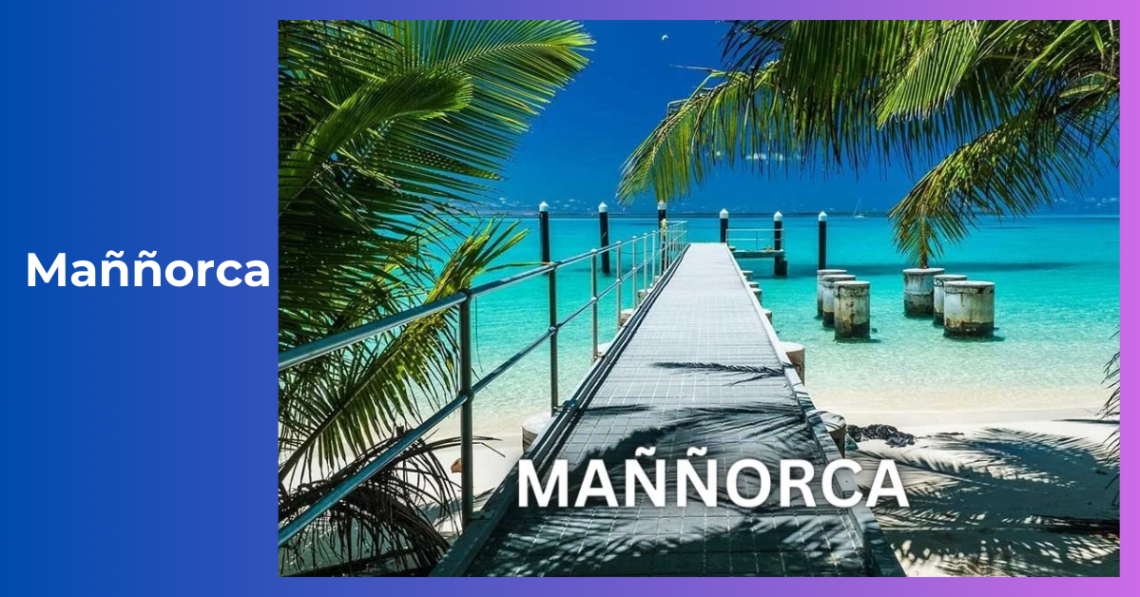
Maññorca _ The Ultimate Guide to a Hidden Mediterranean Gem
Welcome to Maññorca, a hidden gem in the Mediterranean! Known for its unspoiled beaches, charming villages, and rich culture, Maññorca offers a unique travel experience.
Maññorca: Explore Maññorca’s unspoiled beaches, charming villages, and rich culture. Your guide to a hidden Mediterranean gem awaits! Discover the pristine beauty and unique charm of this lesser-known destination, perfect for a tranquil and enriching getaway.
In this comprehensive guide, we’ll explore everything you need to know about Maññorca, from its stunning landscapes and historical sites to local cuisine and travel tips.
Our goal is to provide you with an in-depth understanding of this beautiful island, surpassing existing online sources and helping you plan the perfect trip.
Geography and Climate
Location and Overview
Maññorca, also known as Mallorca, is the largest island in the Balearic Islands, located in the Mediterranean Sea. It’s about 170 kilometers south of Barcelona, Spain.
The island covers an area of approximately 3,640 square kilometers and boasts diverse landscapes, from pristine beaches to rugged mountains.
Climate
Maññorca enjoys a Mediterranean climate, characterized by hot, dry summers and mild, wet winters. The average summer temperatures range from 25°C to 30°C (77°F to 86°F), making it perfect for beach vacations.
In winter, temperatures range from 10°C to 15°C (50°F to 59°F), ideal for exploring the island’s cultural and historical sites.
History of Maññorca
Ancient Times
Maññorca has a rich history that dates back to prehistoric times. The Talayotic culture, known for its megalithic structures, thrived on the island around 1000 BC.
These ancient structures, including talayots, navetas, and taulas, are scattered across the island, offering a glimpse into its early inhabitants’ lives.
Roman Influence
The Romans conquered Maññorca in 123 BC, integrating it into the Roman Empire. During this period, the island saw significant development, including the construction of roads, aqueducts, and towns.
Many Roman ruins can still be found on the island today, such as the remains of the ancient city of Pollentia.
Medieval Period
After the fall of the Roman Empire, Maññorca was occupied by various groups, including the Vandals, Byzantines, and Moors.
The island was reconquered by King James I of Aragon in 1229, marking the beginning of a new era.
During the medieval period, Maññorca flourished as a trading hub, with impressive architectural developments, including Gothic cathedrals and castles.
Unspoiled Beaches of Maññorca
Cala Agulla
Located in the northeast of Maññorca, Cala Agulla is a stunning sandy beach surrounded by pine forests.
The crystal-clear waters and soft sand make it a perfect spot for swimming and sunbathing. It’s a popular destination for both locals and tourists looking to escape the crowds.
Playa de Muro
Playa de Muro, situated on the northeast coast, is known for its fine sand and clear, shallow waters. This beach is ideal for families with children, as the gentle waves make it safe for swimming.
Playa de Muro is also a great spot for water sports, including windsurfing and paddleboarding.
Es Trenc
Es Trenc is one of the most famous beaches in Maññorca, located on the south coast. This unspoiled beach stretches for over two kilometers, offering white sand and turquoise waters.
Es Trenc is often compared to Caribbean beaches, making it a must-visit for beach lovers.
Charming Villages of Maññorca
Valldemossa
Valldemossa is a picturesque village nestled in the Tramuntana Mountains. Known for its cobblestone streets, stone houses, and lush greenery, Valldemossa is a perfect example of traditional Mallorcan architecture.
The village is also famous for the Royal Charterhouse, where the composer Frédéric Chopin spent a winter in 1838.
Deià
Deià is another charming village located in the Tramuntana Mountains. This village has long been a haven for artists, writers, and musicians, drawn by its stunning scenery and tranquil atmosphere.
Stroll through the narrow streets, visit local art galleries, and enjoy breathtaking views of the Mediterranean Sea.
Soller
Soller is a vibrant town situated in a fertile valley surrounded by mountains. The town is known for its beautiful architecture, including the modernist-style Soller Railway Station and the Church of Sant Bartomeu.
Take a ride on the historic tram from Soller to the port, and enjoy the scenic journey through orange and lemon groves.
Also Read :WWW.DIGITALNEWSALERTS.COM _ REVOLUTIONIZING INFORMATION CONSUMPTION
Rich Culture and Heritage
Palma Cathedral
Palma Cathedral, also known as La Seu, is a Gothic masterpiece located in the capital city, Palma. Built on the site of a former mosque, the cathedral boasts stunning architecture, with its impressive rose window and intricate carvings.
Inside, you can find works by the famous architect Antoni Gaudí and the contemporary artist Miquel Barceló.
Bellver Castle
Bellver Castle is a unique circular castle situated on a hill overlooking Palma. Built in the 14th century, it offers panoramic views of the city and the surrounding area.
The castle is also home to the City History Museum, where you can learn about Maññorca’s rich past.
Talayotic Sites
Maññorca is home to numerous Talayotic sites, remnants of the island’s prehistoric culture.
These ancient structures, such as the Naveta des Tudons and the Talaiot Capocorb Vell, provide a fascinating glimpse into the lives of Maññorca’s early inhabitants. Exploring these sites is like stepping back in time.
Activities and Adventures
Water Sports
Maññorca offers a wide range of water sports for adventure seekers. From sailing and windsurfing to scuba diving and snorkeling, there’s something for everyone.
The island’s clear waters and diverse marine life make it a top destination for underwater exploration.
Hiking and Cycling
With its diverse terrain, Maññorca is a paradise for hikers and cyclists. The Serra de Tramuntana mountain range offers numerous trails, ranging from easy walks to challenging hikes.
For cyclists, the island’s well-maintained roads and scenic routes provide an excellent opportunity to explore its natural beauty.
Exploring Caves
Maññorca is known for its impressive cave systems, including the famous Caves of Drach and Caves of Artà.
These caves feature stunning stalactites and stalagmites, as well as underground lakes. Guided tours are available, providing an educational and awe-inspiring experience.
Local Cuisine
Traditional Dishes
Paella
Paella is a famous Spanish dish, and in Maññorca, it’s often made with fresh seafood. This delicious rice dish is cooked with a variety of ingredients, including shrimp, mussels, and squid, seasoned with saffron and other spices.
Sobrasada
Sobrasada is a traditional Mallorcan sausage made from pork, paprika, and other spices. This spreadable sausage is typically eaten with bread and is a staple in local cuisine.
Tumbet
Tumbet is a classic vegetable dish made with layers of fried potatoes, eggplants, and bell peppers, topped with tomato sauce. It’s often served as a side dish or as a main course with meat or fish.
Local Wines
Maññorca has a burgeoning wine industry, with several local vineyards producing high-quality wines. The island’s unique climate and soil contribute to the distinct flavors of its wines.
Be sure to visit local wineries for tastings and tours, and sample varieties such as Manto Negro, Callet, and Prensal Blanc.
Accommodation
Luxury Resorts
Cap Rocat
Cap Rocat is a luxurious hotel set in a former military fortress, offering stunning views of the Mediterranean.
This exclusive resort provides top-notch amenities, including a spa, infinity pool, and private beach access.
Belmond La Residencia
Belmond La Residencia is a five-star hotel located in the charming village of Deià.
Surrounded by olive and citrus groves, this hotel offers elegant rooms, a renowned restaurant, and an award-winning spa.
Budget Options
Hostels
Maññorca has several hostels, especially in Palma, offering affordable accommodation for backpackers and budget travelers. These hostels provide basic amenities, communal areas, and often organize social events.
Vacation Rentals
Vacation rentals are a popular option for visitors looking for a more personalized experience. From apartments in Palma to villas in rural areas, there are plenty of choices to suit different budgets and preferences.
Also Read :EXPLORING THE IMPACT OF FTSE 100 FINTECHZOOM
Travel Tips
Best Time to Visit
The best time to visit Maññorca is during the spring (April to June) or fall (September to October). During these periods, the weather is pleasant, and the island is less crowded compared to the peak summer months.
Spring and fall also offer ideal conditions for outdoor activities such as hiking and cycling.
Getting Around
Renting a car is the most convenient way to explore Maññorca. The island has a well-maintained road network, and having a car allows you to visit remote beaches and villages at your own pace.
Public transport is also available, with regular bus services connecting major towns and tourist destinations.
Language
While Spanish (Castilian) is the official language, Catalan is also widely spoken in Maññorca. Many locals speak English and German, especially in tourist areas, so communication is generally easy for visitors from the USA.
Conclusion
Maññorca is a hidden Mediterranean gem that offers something for everyone.
Whether you’re looking for relaxation on pristine beaches, adventure in the mountains, or a dive into rich history and culture, Maññorca is the perfect destination.
By exploring its unspoiled beaches, charming villages, and vibrant culture, you’ll experience a unique side of the Mediterranean that goes beyond the typical tourist experience.
Start planning your trip to Maññorca today, and discover all the wonders this beautiful island has to offer!
FAQs
What is the best time of year to visit Maññorca?
The best time to visit Maññorca is during the spring (April to June) or fall (September to October) when the weather is pleasant, and the crowds are smaller.
Is Maññorca a family-friendly destination?
Yes, Maññorca is a family-friendly destination with plenty of activities and attractions for all ages, including beaches, water parks, and cultural sites.
What is the local currency in Maññorca?
The local currency in Maññorca is the Euro (€).
Do I need a visa to visit Maññorca?
If you are a US citizen visiting Maññorca for tourism for up to 90 days, you do not need a visa. However, you must have a valid passport.
Are there any local customs I should be aware of?
In Maññorca, it’s customary to greet people with a handshake or a kiss on both cheeks. When dining, it’s polite to wait for the host to begin eating before you start.
You May Also Like

Unlocking the Secrets of Guia Silent Hill Geekzilla _ A Comprehensive Guide
July 19, 2024
Understanding Evırı _ A Deep Dive into Turkish Cultural Heritage
July 25, 2024

